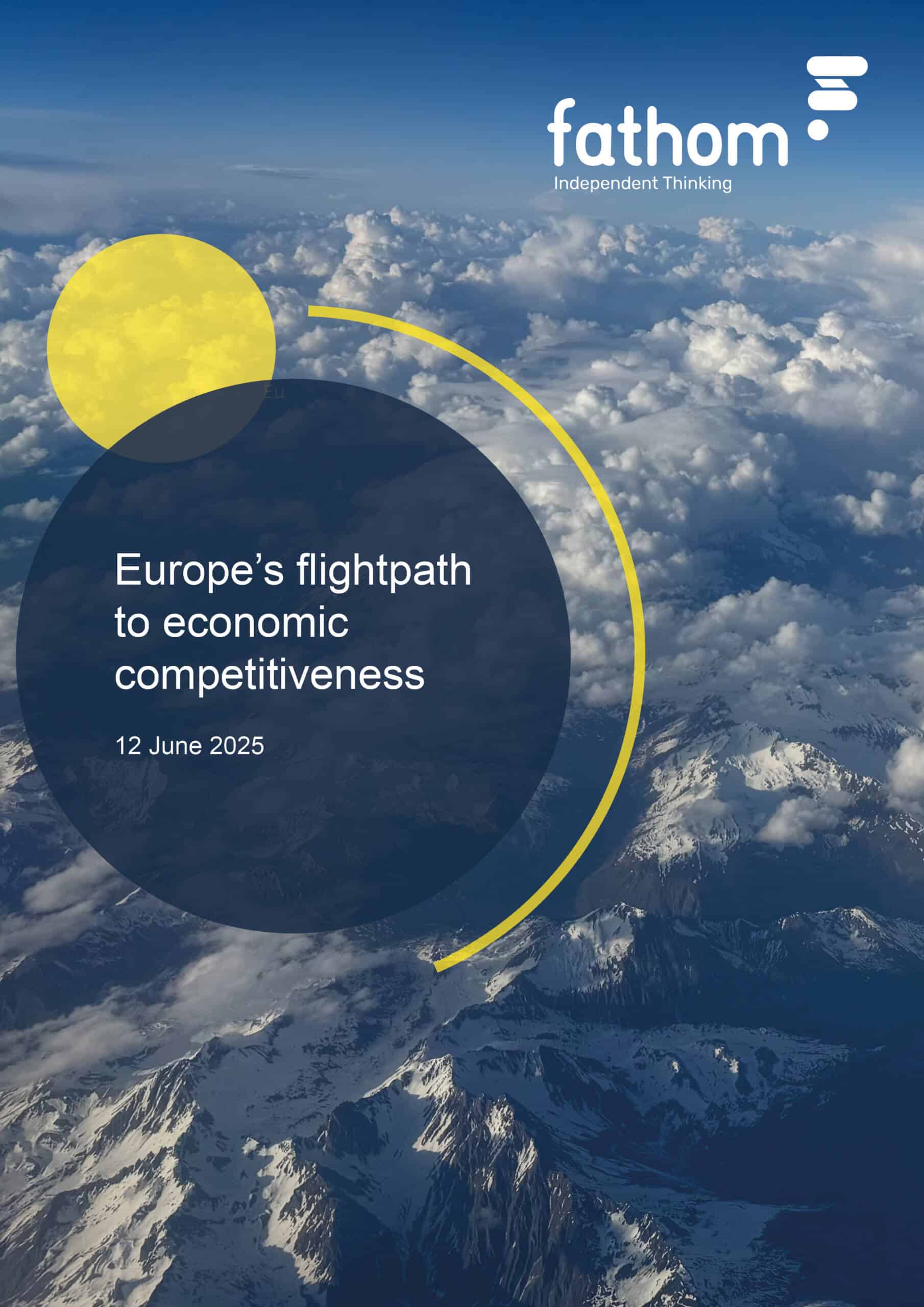Summary
Fathom was asked by the European Climate Foundation to consider how decarbonising aviation can support broader European policy objectives such as boosting economic competitiveness and productivity. To answer, we built a model assessing the costs of flying using different types of sustainable aviation fuels (SAFs), e-kerosene and hydrogen-powered zero emission flight (ZEF), compared to the costs of fossil kerosene. The model’s unique features include demonstrating how costs and benefits vary at different levels of decarbonisation, at different points in time and using different assumptions. We found that in most scenarios ZEF will become the cheapest low-carbon form of flying, when scaled. We also showed how the R&D needed to commercialise ZEF will have substantial benefits to the wider economy. We linked these findings to current industry trends, EU and UK policies and strategic objectives, to make recommendations to businesses and policymakers.
Key facts
Client
European Climate Foundation
Brief
To understand the economic costs, benefits and opportunities of different ways to decarbonise aviation, and how each can promote Europe’s wider policy agenda
Timescale
Phased over 13 months
Focus area
Climate economics
Our approach
Fathom applies the same rigorous, proven process to every piece of work; this process is the DNA that makes up our world-leading research.
When it comes to decarbonising aviation, the prevailing policy framework and industry narrative is centred on SAFs which are largely consistent with existing infrastructure. However, there is mounting evidence that the waste-based SAFs favoured by policymakers are not scalable, and costs will rise significantly at low levels of decarbonisation due to limited feedstock. E-kerosene (considered a type of SAF under EU and UK legislation) offers more promise but has other drawbacks. Little focus is given to ZEF, perhaps due to the technology’s large up-front costs, such as R&D and the need for significant changes to aircraft fleets and infrastructure.
The costs associated with SAF and opportunities associated with ZEF are not secrets, but since undertaking this project, it became clear to us that the true drivers of these costs and benefits were not well understood and had not been quantified in an easily comparable way.
Fathom’s Aviation Decarbonisation Model (FADM), which levelises the costs of the different decarbonisation options, overcomes some of these shortcomings by allowing for a clearer comparison of their costs and benefits, and a better understanding of the conditions under which they change.
We ensured that externalities both positive (R&D spillovers) and negative (higher economy-wide electricity prices) would be considered in the model. In most scenarios, such as our central scenario below, we found that ZEF becomes the cheapest form of low-carbon flying when scaled, even if all of the large upfront costs are borne by the aviation sector. We also found that when the economic benefits from ZEF R&D spillovers were taken into account and subtracted from ticket prices that it would be cheaper to fly with ZEF than it would with fossil kerosene at all levels of decarbonisation.
We drew on a wide literature which explains how aerospace R&D can boost the wider economy and combined this with FADM, our proprietary model, to show the benefits of ZEF. We also contextualised these findings: Europe does less a lot less R&D than the US, which helps explain Europe’s productivity shortfall vis-à-vis the US; now that the US is pulling back from climate and research funding, this could create an opportunity for Europe. Meanwhile, we explained that China’s domination of other clean technologies shows the danger of failing to lead on decarbonisation and high-end manufacturing. Our work contained several key conclusions, as well as recommendations for policymakers and businesses.
Delivery
The project was delivered in successive stages, in which Fathom:
- Shared preliminary findings with an advisory group of key stakeholders
- Organised and hosted an event in Brussels in April 2025 to disseminate preliminary findings
- Presented findings to the European Commission in Brussels
- Delivered a keynote presentation at Farnborough Sustainable Skies 2025
- Circulated the report digitally to more than 1000 people
- Created a website landing page with information about the work
Key calls
- European policymakers should look beyond non-scalable, waste-based SAF technologies, whose value is mainly in the short term
- The costs of waste-based SAFs are likely to spiral when less than 15% of European aviation is decarbonised, due to feedstock constraints; while the costs of flying with e-kerosene and ZEF are high now but are likely to fall – in most future scenarios, when scaled, ZEF becomes the cheapest low-carbon way to fly
- By committing support and investment to ZEF, EU policymakers can bring down the long-term cost of flying as well as achieving net-zero aviation
- While long-haul ZEF technologies are evolving, ZEF should be prioritised for short-haul flights, and waste-based SAFs should be prioritised for long-haul flights
- ZEF R&D will have significant spillover benefits for the wider economy, with the applications of hydrogen technology likely to be taken up by other sectors such as automotive, space and medical – boosting productivity and European competitiveness
- France and the UK are likely to be the biggest beneficiaries from ZEF R&D, while more peripheral EU economies like Malta and Cyprus will benefit most from the new airport infrastructure related to ZEF
- If the spillover benefits of ZEF R&D were subtracted from ZEF operating costs, in most scenarios in 2050 it would be cheaper to fly with ZEF than with fossil kerosene
- Seizing first-mover advantage in ZEF could help Europe to counteract rising competition from China in the aviation and clean energy sectors
- But the energy security benefits from e-kerosene and ZEF will only be available if Europe expands domestic production of clean electricity and hydrogen – moreover, insufficient clean electricity could result in higher economy-wide electricity costs, undermining productivity
Impact
- During the project the report message reached key stakeholders, with policymakers contacting Fathom to discuss our findings
- Press coverage of the report introduced it to a wider audience
- Shortly after publication the EU announced more than €20 billion of funding towards aviation research and innovation, in which future flight technologies, including ZEF, played a key part
- Similarly, the UK government announced £500 million towards green hydrogen infrastructure and £250 million for green air technologies, while also committing up to £2.3 billion in funding to the ATI for another ten years
- Our unique analytical approach and impactful findings received positive feedback from stakeholders including representatives of airlines, aircraft manufacturers and airports
Report in the news
Get in touch
For more information about our services or to discuss your needs and how we can help, please submit the form below:


